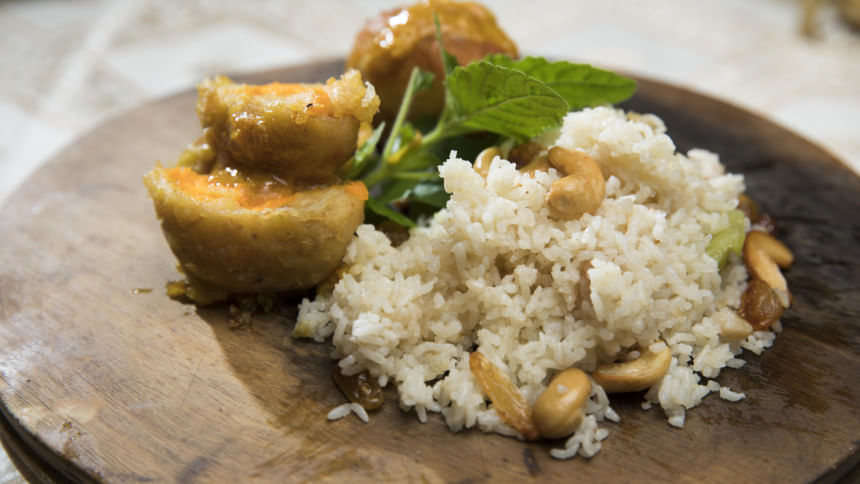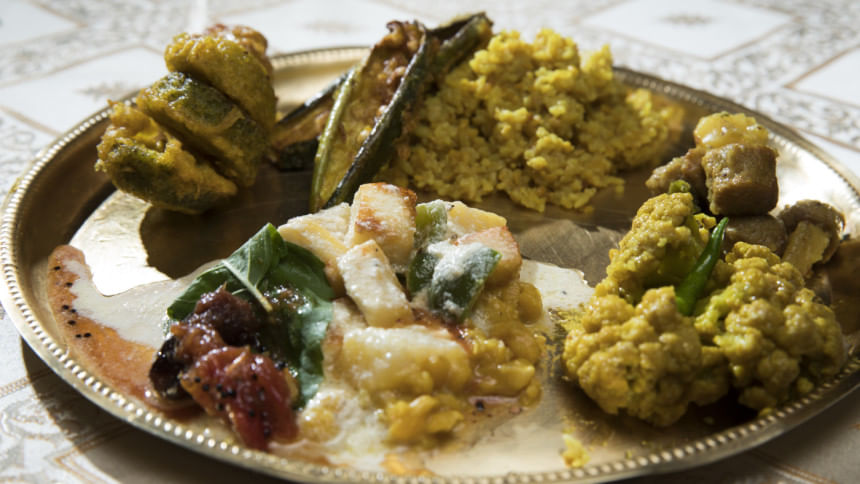Durga’s feast: From luchi to payesh, tradition reborn

The elaborate and painstakingly selected menu for the divine daughter is the best of South Asian vegetarian recipes; puffed up soft luchi (flatbread) that has a pearly sheen from being deep fried, potato curry, or alu'r daam as we call it locally, a mixed lentil curry and vegetable labra, and a hog plum or amra'r chutney.
I die for Durga's food fest -- I call it Durga bhoj payesh, a sort of rice pudding made with binni chal or sticky rice. Mandatory in the menu are the coconut balls, our good old naru made with jaggery. This is what Sharat's dreams are made of.
The community pujas have their own menu, made for the mass feeding; khichuri, which is basically turmeric rice with vegetables. It is called bhog or devi offering. But bonedi or elite Hindu households in Dhaka go for their best menu plan.
"Ma khay shontaner jonno," the verbatim translation of this quote by Srimati Shaha, Director of Kumudini Welfare Trust, relays that generally a mother feeds herself only to feed and replenish her children.
"The deep religious meaning behind her thought is that Ma Durga's arrival calls for a festive and special menu. Though she does not partake in the food offering bestowed on her by humans. It is a symbolic gesture," explains Shaha, the matriarch of renowned pujas held at Kumudini.
Boudi or Mashi ma, as she is fondly called by her fans like me, goes on to describe the well-thought-out and meticulously prepared menu for Ma Durga. There is no chance of mistaking the Amish (non-vegetarian) and Niramish (vegetarian) food items. Rice dishes cooked or steamed in flavourful spices like cinnamon, cardamom, star anise, and clarified butter, called Ghee Bhaat, are served with vegetable fritters, niramish, and an assortment of sweets made from ricotta cheese, which is cchana.
"The cherished puja sweet is Malpua, the mention of which is deeply rooted in our ancient texts. Big in size with a soft core and crunchy edges, Malpua is made with a thin batter of flour, and soaked in a simple sugar and aromatic syrup. Shaheb Barir Malpua was what people called them in our home," the graceful Srimati Shaha recalls.

Akhter Jahan, writer and educator, is best known for writing her personal stories and memories of Old Dhaka in Sobbas or Khosbas, a Bengalinized dialect of Urdu and Hindi, that is native to Old Dhaka. She recalls in one of her memoirs about how she celebrated puja during her childhood.
"On the auspicious day of Ashtami, I was fortunate enough to be invited to a Banedi family's Durga Puja, where my father and I sat on the ground, feasting on luchi and payesh, spread on banana leaves. Amid the exchange of colourful platters of sweets, candies, and giant rosogollas, I would sneak a prasad, my tiny hands clutching sweet Naru, my Hindu aunts and friends would share. There would be a puja mela or fair near the mandaps. The fairs were like my magic portals, fun rides, and delicious snacks like spicy mirchini, fried lentil balls, jaggery, and sesame treats. Each bite was a tiny universe of flavour, and each purchase a prayer for happiness," Akhter Jahan writes.
The shared puja rituals and food silently made a bond with us, the non-Hindu neighbours. The sweet aroma and flavours mingling with the spices of their bhog remain our favourite vegetarian meal.
The colours of puja, the intoxicating smell of dhoop, and the maddening sound of Dhaks, and the ancient rhythm of Durga's worship, are my reasons to go Mandap hopping in and around Dhaka.
The Hindu community's soul beats the strongest during Durga Puja, and for us enthusiasts, the vibrant and pulsating festival is a testimony to a harmonious city's soul.

 For all latest news, follow The Daily Star's Google News channel.
For all latest news, follow The Daily Star's Google News channel. 



Comments